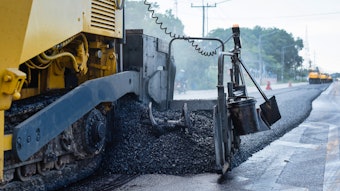
Hot In-Place Recycling (HIR) has many benefits. This process is an on-site, in-place method that rehabilitates deteriorated asphalt pavement and minimizes the use of new materials.
During this time of rapidly increasing costs and limited funding, HIR presents the opportunity to spread available dollars over a much greater area. Roadway deterioration can be suspended, pavement preserved and upgraded, and costly reconstruction avoided.
“HIR is a great option for many agencies,” says Mary Beth Howard, project engineer with Gallagher’s Hot In-Place Asphalt Recycling Division, which is considered a pioneer of HIR. “This process typically goes in lieu of milling, and because HIR does not take material away from the roadway, it helps build structure.
HIR also uses heat which penetrates below the depth of the scarification tines, says Howard. “This allows cracks, in an oil-rich environment, to mend together where they otherwise would not have been touched. In addition, HIR is a much more affordable option compared to other various road treatment options.”
Waukesha County Roads
Located in Southeastern Wisconsin, just west of Milwaukee, Waukesha County recognizes the many benefits of the HIR process and has worked with Gallagher for over 12 years preserving roads with this method.
Over the course of a month in the summer of 2016, Gallagher recycled portions of five county highways for Waukesha County.
The roads featured myriad problems, including centerline distress, transverse cracking, wheel track rutting and alligator cracking. Classic symptoms of roads that can be fixed using HIR.
HIR can be performed as either a single-pass (one phase) operation that monolithically recombines the restored pavement with virgin material or as a two-pass procedure, where the restored material is recompacted and the application of the new wearing surface then follows a prescribed interim period that separates the process into two distinct phases.
In the case of the Waukesha County roads, Gallagher used an HIR process composed of two pre-heaters, one main-heater/recycler, and a roller for a single-pass operation.
During the operation, two pre-heaters go ahead of the recycler to gradually heat up the road and prep it for deep scarification. The recycler then follows in tandem.
The recycler has its own oven which increases the temperature of the road one final time before the rejuvenating agent is applied and the scarification tines pass through at a 1.5-inch nominal depth.
This rejuvenated material is then tumbled through an ever-spinning auger, which feeds right into the screed. The screed continues to lay the material in a semi-compacted fashion. This mat is called “complete” when the roller passes over the road to complete compaction.
“HIR requires an overlay of some sort in order for the entire road to be considered complete,” says Howard. “However, the road is open to traffic immediately after the roller passes, which is another added benefit to the HIR process.”
Customized equipment
All of Gallagher’s equipment is customized or has been turned customized over the course of many years. “Many changes have been done to the equipment to make the process safer, more cost effective, and to deliver a better product,” says Howard.
Gallagher’s trains typically run at a pace of 15 feet per minute. The speed can vary due to conditions such as ambient temperature, previous roadway conditions, residual precipitation on the roadway and more.
“If you were to drop a penny on the road, and timed the process from the time the first preheater reached the penny, to when the roller passed the penny, the entire interval should take around 15 minutes,” says Howard. “This includes engineered machine spacing and pace.”
One of the challenges of the Waukesha County project was heavy traffic. “It’s important to remember that safety comes first, and many cars get easily frustrated with construction and the workers,” she says. “It’s important to remember that the guys doing the work are at a very high-risk job. We very much appreciate slow-moving vehicles and patience.”
To combat this challenge, Gallagher has flaggers and traffic signs at all of its jobsites and makes sure all crew members are flagger-certified in case someone needs to step in as an additional flagger.
Green benefits
HIR enables public works officials and municipalities to effectively re-use existing materials by restoring the pavement in place, making it a very green process. The process is designed to reduce the overall carbon footprint by 28% versus conventional “mill & fill” resurfacing and overall trucking needs by over 50% or more.
“Our process does not require truck hauling or an asphalt plant to be operable,” says Howard. “This cuts out a lot of environmental emissions which otherwise would be present at a traditional mill-and-fill operation.
“The reduction in the amount of truck trips required versus conventional grind and overlay is typically by 75%,” she continues. “This translates to huge improvements in congestion and user delays, as well as the agency’s other roads not getting beaten up by the truck trips.”
Overall, the Waukesha County project with Gallagher was another success as it's been for many years now, says Howard.
“We very much enjoy working for Waukesha County and look forward to continuing our work there,” she says.

























